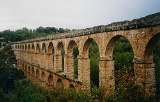
Aqüeducte de les Ferreres
Encyclopedia
The Aqüeducte de les Ferreres (əkwəˈðuktə ðə ɫəs fəˈreɾəs; also known as Pont del Diable in Catalan
, Devil's Bridge) is a Roman aqueduct
in Catalonia
, Spain
built to supply water to the ancient city of Tarraco
. The aqueduct is located 4 kilometers north of Tarragona
, in the Autonomous Community of Catalonia
. The aqueduct
is part of the Archaeological Ensemble of Tarraco
, which was added to the UNESCO's list of World Heritage Site
s in 2000.
river, 15 kilometers north of Tarragona. It probably dates from the time of Augustus
. The aqueduct has a maximum height of 27 m and a length of 249 m, including the ends where the specus (water channel) runs atop a wall. It is composed of two levels of arches: the upper section has 25 arches, and the lower one has 11. All arches have the same diameter of 20 Roman feet
(5.9m) with a variation of 15 cm. The distance between centres of the pillars is 26 Roman feet (7.95m).
Catalan language
Catalan is a Romance language, the national and only official language of Andorra and a co-official language in the Spanish autonomous communities of Catalonia, the Balearic Islands and Valencian Community, where it is known as Valencian , as well as in the city of Alghero, on the Italian island...
, Devil's Bridge) is a Roman aqueduct
Roman aqueduct
The Romans constructed numerous aqueducts to serve any large city in their empire, as well as many small towns and industrial sites. The city of Rome had the largest concentration of aqueducts, with water being supplied by eleven aqueducts constructed over a period of about 500 years...
in Catalonia
Catalonia
Catalonia is an autonomous community in northeastern Spain, with the official status of a "nationality" of Spain. Catalonia comprises four provinces: Barcelona, Girona, Lleida, and Tarragona. Its capital and largest city is Barcelona. Catalonia covers an area of 32,114 km² and has an...
, Spain
Spain
Spain , officially the Kingdom of Spain languages]] under the European Charter for Regional or Minority Languages. In each of these, Spain's official name is as follows:;;;;;;), is a country and member state of the European Union located in southwestern Europe on the Iberian Peninsula...
built to supply water to the ancient city of Tarraco
Tarraco
Tarraco is the ancient name of the current city of Tarragona . During the Roman Empire was one of the major cities of the Iberian Peninsula and capital of the Roman province called Hispania Citerior or Hispania Tarraconensis. The full name of the city at the time of the Roman Republic was Colonia...
. The aqueduct is located 4 kilometers north of Tarragona
Tarragona
Tarragona is a city located in the south of Catalonia on the north-east of Spain, by the Mediterranean. It is the capital of the Spanish province of the same name and the capital of the Catalan comarca Tarragonès. In the medieval and modern times it was the capital of the Vegueria of Tarragona...
, in the Autonomous Community of Catalonia
Catalonia
Catalonia is an autonomous community in northeastern Spain, with the official status of a "nationality" of Spain. Catalonia comprises four provinces: Barcelona, Girona, Lleida, and Tarragona. Its capital and largest city is Barcelona. Catalonia covers an area of 32,114 km² and has an...
. The aqueduct
Aqueduct
An aqueduct is a water supply or navigable channel constructed to convey water. In modern engineering, the term is used for any system of pipes, ditches, canals, tunnels, and other structures used for this purpose....
is part of the Archaeological Ensemble of Tarraco
Tarraco
Tarraco is the ancient name of the current city of Tarragona . During the Roman Empire was one of the major cities of the Iberian Peninsula and capital of the Roman province called Hispania Citerior or Hispania Tarraconensis. The full name of the city at the time of the Roman Republic was Colonia...
, which was added to the UNESCO's list of World Heritage Site
World Heritage Site
A UNESCO World Heritage Site is a place that is listed by the UNESCO as of special cultural or physical significance...
s in 2000.
Description
The aqueduct took water from the FrancolíFrancolí
The Francolí is a river in Catalonia . Its source is in the Prades Mountains and it flows into the Mediterranean Sea at Tarragona....
river, 15 kilometers north of Tarragona. It probably dates from the time of Augustus
Augustus
Augustus ;23 September 63 BC – 19 August AD 14) is considered the first emperor of the Roman Empire, which he ruled alone from 27 BC until his death in 14 AD.The dates of his rule are contemporary dates; Augustus lived under two calendars, the Roman Republican until 45 BC, and the Julian...
. The aqueduct has a maximum height of 27 m and a length of 249 m, including the ends where the specus (water channel) runs atop a wall. It is composed of two levels of arches: the upper section has 25 arches, and the lower one has 11. All arches have the same diameter of 20 Roman feet
Ancient Roman units of measurement
The ancient Roman units of measurement were built on the Hellenic system with Egyptian, Hebrew, and Mesopotamian influences. The Roman units were comparatively consistent and well documented.-Length:Notes...
(5.9m) with a variation of 15 cm. The distance between centres of the pillars is 26 Roman feet (7.95m).
See also
- Roman bridges
- List of Roman aqueduct bridges

